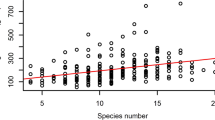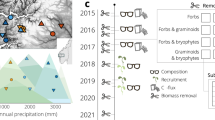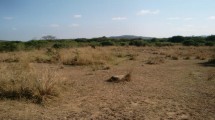Abstract
Previously published data on production biology, energy use efficiency, nutrient availability and vulnerability were reinterpreted for the explanation of community processing and structure in high altitude grasslands of the Alps. The final goal of the approach was to present a characterization of these plant communities in generalized terms.
The keystone-concept was applied, and the alpine grasslands then defined as plant communities with one or a few keystone species. Associated species show a varying degree of interdependence from these keystones. They form guilds exploiting resources not needed by the latter. As many of these species belong to these groups, and alpine grasslands are commonly species rich, a high functional redundancy is typical for these communities.
Similar content being viewed by others
References
Billings, W. D. 1979. High mountain ecosystems. In: Webber, P. J. (ed.), High altitude geoecology. AAS Selected Symposium 12: 97–125.
BraunJ. 1913. Die Vegetationsverhältnisse der Schneestufe in den Rätisch-Lepontischen Alpen. Neue Denkschrift Schweiz. Naturforsch. Ges. 48: 1–347.
Braun-BlanquetJ. & JennyH. 1926. Vegetationsentwicklung und Bodenbildung in der alpinen Stufe der Zentralalpen. Denkschrift Schweiz. Naturf. Ges. 63: 183–349.
CernuscaA. 1977. Alpine Grasheide Hohe Tauern. Ergebnisse der Ökosystemstudie 1976. Veröffentl. Österr. MaB-Hochgebirgsprogrammes Hohe Tauern. Band 1. Wagner. Innsbruck.
FranzH. (ed.) 1980. Untersuchungen an alpinen Böden in den Hohen Tauern 1974–1978. Stoffdynamik und Wasserhaushalt. Veröffentl. Österr. MAB-Hochgebirgsprogramms Hohe Tauern. Band 3. Wagner. Innsbruck.
FranzH. (ed.) 1981. Bodenbiologische Untersuchungen in den Hohen Tauern 1947–1978. Veröffentl. Österr. MAB-Hochgebirgsprogramms Hohe Tauern. Band 4. Wagner. Innsbruck.
FranzH. (ed.) 1985. Beitrage zu den Wechselbeziehungen zwischen Hochgebirgsökosystemen und den Menschen. Veröffentl. Österr. MAB-Hochgebirgsprogramms Hohe Tauern. Band 9. Wagner, Innsbruck.
GrabherrG. 1982. The impact of trampling by tourists on a high altitudinal grassland in the Tyrolean Alps, Austria. Vegetatio 48: 209–217.
GrabherrG. 1987. Produktion und Produktionsstrategien im Krummseggenrasen (Caricetum curvulae) der Silikatalpen und ihre Bedeutung für die Bestandestruktur. In: PatzeltG. (ed.), MaB-Projekt Obergurgl. Veröff. Österr. MaB-Programms, Band 10. Wagner. Innsbruck.
GrabherrG., MährE. & ReisiglH. 1978. Nettoprimärproduktion und Reproduktion in einem Krummseggenrasen (Caricetum curvulae) der Ötztaler Alpen, Tirol. Oecol. Plant. 13: 227–251.
GrabherrG., BrzoskaW., HoferH. & ReisiglH. 1980. Energiebindung und Wirkungsgrad der Nettoprimärproduktivität in einem Krummseggenrasen (Caricetum curvulae) der Ötztaler Alpen, Tirol. Oecol. Plant. 15: 307–316.
GrabherrG., MairA. & StimpflH. 1985. Wachstums- und Reproduktionsstrategien von Hochgebirgspflanzen und ihre Bedeutung für die Begrünung von Schipisten und anderen hochalpinen Erosionsflächen. Verhandl. Ges. für Ökol. 15: 183–188.
GrimeJ.P., HodgsonJ.G. & HuntR. 1987. Comparative plant ecology — a functional approach to common Britisch plants and communities. Blackwell, Oxford.
Klug-PümpelB. 1982. Effects of microrelief on species distribution and phytomass variations in Caricetum curvulae stand. Vegetatio 48: 249–255.
Larcher, W. 1977a. Produktivität und Überlebensstrategien von Pflanzen und Pflanzenbeständen im Hochgebirge. Sitzungsber. Österr. Akademie der Wissensch., Math.-naturwiss. Kl., Abt.I, 186. Bd., 6–10. Heft: 373–386.
Larcher, W. 1977b. Ergebnisse des IBP-Projekts ‘Zwergstrauchheide Patscherkofel’. Sitzungsber. Österr. Akademie der Wissensch., Math.-naturwiss. Kl., Abt.I, 186. Bd., 6–10. Heft: 301–371.
Mähr, E. & Grabherr, G. 1983. Wurzelwachstum und-produktion in einem Krummseggenrasen (Caricetum curvulae) der Hochalpen. In: Böhm, S. & Kutschera, L. (eds.), Wurzelökologie und ihre Nutzanwendung, pp. 405–416. Bundesanstalt Gumpenstein. Irdning (Austria).
Lovett DoustL. & Lovett DoustJ. 1982. The battle strategies of plants. New Scientist 95: 81–85.
OhbaT. 1974. Vergleichende Studien über die alpine Vegetation Japans 1. Carici rupestris-Kobresietea bellardi. Phytocoenologia 1: 339–401.
Lovett DoustL. & Lovett DoustJ. 1982. The battle strategies of plants. New Scientist 95: 81–85.
OhbaT. 1974. Vergleichende Studien über die alpine Vegetation Japans 1. Carici rupestris-Kobresietea bellardi. Phytocoenologia 1: 339–401.
O'NeillR. V., DeAngelisD. L., WaideJ. B. & AllenT. F. H. 1986. A hierarchical concept of ecosystems. Princeton University Press. Princeton, New Jersey.
PaineR. T. 1966. Food web complexity and species diversity. Am. Nat. 100: 65–75.
PatzeltG. 1987. MAB-Projekt Obergurgl. Veröffentlichungen des österreichischen MAB-Programmes, Band 10. Wagner, Innsbruck.
RehderH. 1978. Nutrient turnover studies in alpine ecosystems. IV. Communities of the Central Alps, a comparative survey. Oecologia 34: 309–327.
Rübel, E. 1912. Pflanzengeographische Monographie des Berninagebietes. Leipzig.
SilvertownJ. & SmithB. 1988. Gaps in the canopy: the missing dimension in vegetation dynamics. Vegetatio 77: 57–60.
TilmanD. 1988. Plant strategies and the dynamics and structure of plant communities. Princeton University Press. Princeton New Jersey.
TitlyanovaA. A., RuschG. & van derMaarelE. 1988. Biomass structure on Öland in relation to grazing intensity. Acta Phytogeogr. Suec. 76: 125–134.
van derMaarelE. 1988. Vegetation dynamics: patterns in time and space. Vegetatio 77: 1–7.
Author information
Authors and Affiliations
Rights and permissions
About this article
Cite this article
Grabherr, G. On community structure in high alpine grasslands. Vegetatio 83, 223–227 (1989). https://doi.org/10.1007/BF00031694
Accepted:
Issue Date:
DOI: https://doi.org/10.1007/BF00031694




